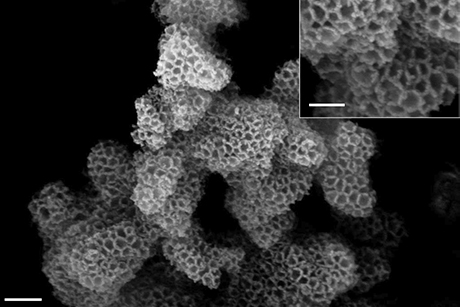搜索结果: 1-11 共查到“理学 Sponges”相关记录11条 . 查询时间(0.053 秒)
Forget sponges:the earliest animals were marine jellies
Forget sponges the earliest animals marine jellies
2017/4/27
When cartoonist and marine-biology teacher Steve Hillenburg created SpongeBob SquarePants in 1999, he may have backed the wrong side of one of the longest-running controversies in the field of evoluti...

In the fight against global warming, carbon capture – chemically trapping carbon dioxide before it releases into the atmosphere – is gaining momentum, but standard methods are plagued by toxicity, cor...
Complex interactions between marine sponges and their symbiotic microbial communities
Complex interactions marine sponges symbiotic microbial communities
2014/4/4
To investigate the importance of symbiont-derived nutrition to host sponges, we coupled manipulative shading experiments with stable isotope analyses of isolated symbiont and host cell fractions. Expe...
Heterogeneous oxygenation resulting from active and passive flow in two Mediterranean sponges,Dysidea avaraandChondrosia reniformis
Heterogeneous oxygenation resulting active passive flow in two Mediterranean sponges Dysideaavara Chond rosia reniformis
2014/4/17
The oxygen dynamics and pumping behavior inDysidea avaraand Chondrosia reniformis(Porifera,Demospongiae) were investigated using oxygen microelectrodes and heated thermistor flow sensors. Both field a...
Ordovician sponges (Porifera) and other silicifications from Baltica in Neogene and Pleistocene fluvial deposits of the Netherlands and northern Germany
Baltica Eridanos River erratics Ordovician Porifera silicifications
2009/10/21
Fluvial deposits of Miocene to Early Pleistocene age in Germany and the Netherlands were laid down in the delta of the Eridanos River System, but the exact provenance of this material continues to be ...
The unique skeleton of siliceous sponges (Porifera;Hexactinellida and Demospongiae) that evolved first from the Urmetazoa during the Proterozoic:a review
unique skeleton siliceous sponges Urmetazoa Proterozoic
2010/1/14
Sponges (phylum Porifera) had been considered as an enigmatic phylum, prior to the analysis of their genetic repertoire/tool kit. Already with the isolation of the first adhesion molecule, galectin, i...
Sponges as a source of dissolved inorganic nitrogen: Nitrification mediated by temperate sponges
Sponges source of dissolved inorganic nitrogen Nitrification mediated temperate sponges
2014/4/22
We evaluated rates of carbon and nitrogen ingestion from particulate organic matter and dissolved inorganic nitrogen excretion by six common sponge species from Mediterranean sublittoral rocky bottom ...
In situ feeding and metabolism of glass sponges (Hexactinellida, Porifera) studied in a deep temperate fjord with a remotely operated submersible
In situ feeding and metabolism glass sponges (Hexactinellida, Porifera) studied a deep temperate fjord remotely operated submersible
2014/4/22
Glass sponges are conspicuous inhabitants of benthic communities in the cool waters of the Antarctic and north Pacific continental shelf. We used an ROV outfitted with a new device for simultaneous sa...
Virus predation by sponges is a new nutrient-flow pathway in coral reef food webs
Virus predation by sponges new nutrient-flow pathway coral reef food webs
2014/5/4
The removal efficiency of viral particles by the coral reef sponge Negombata magnifica was measured. Virus particles were removed by the sponge at an average efficiency of 23.3% ± 2.9%. Significant am...
Sponges and ascidians control removal of particulate organic nitrogen from coral reef water
Sponges and ascidians control removal particulate organic nitrogen coral reef water
2014/5/13
We studied removal rates of plankton and total particulate organic nitrogen (PON) by benthic reef communities from the overlying water in a large experimental flume. The flume was filled with mixtures...
Siliceous sponges as a silicon sink: An overlooked aspect of the benthopelagic coupling in the marine silicon cycle
Siliceous sponges silicon sink bathypelagic coupling marine silicon cycle
2014/5/9
Our current understanding of the silicon (Si) cycle in the ocean assumes that diatoms dominate not only the uptake of silicic acid, but also the production and recycling of biogenic silica (BSi), and ...

